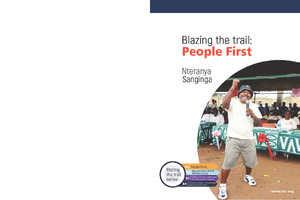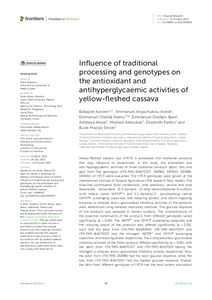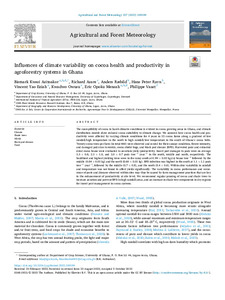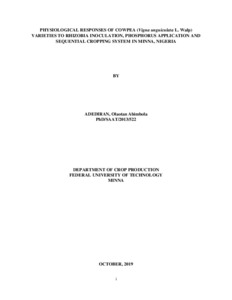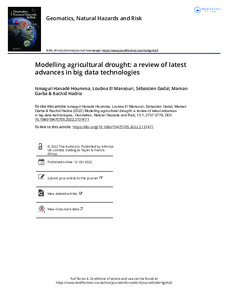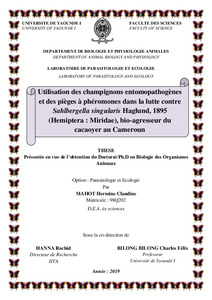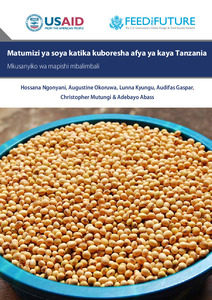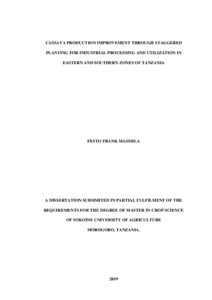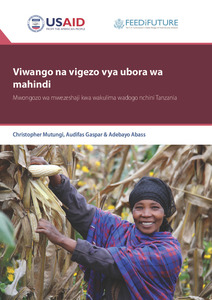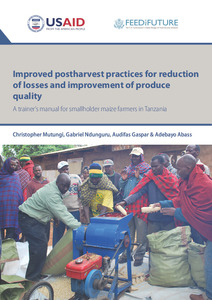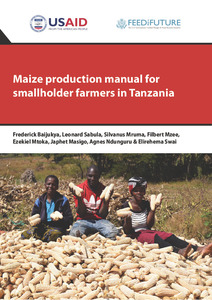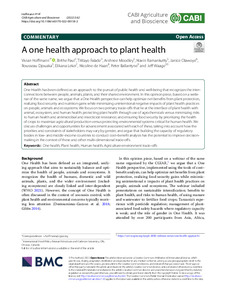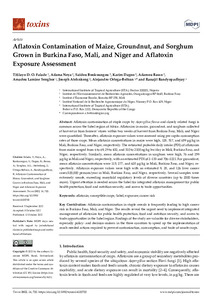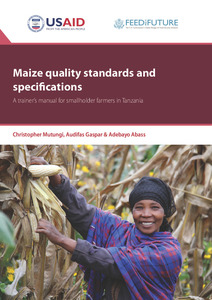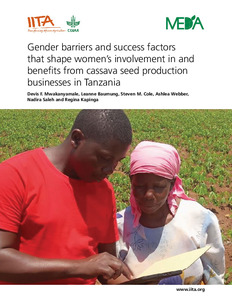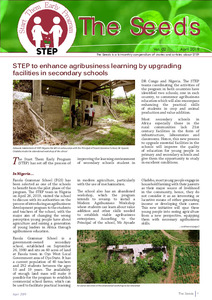Welcome to the International Institute of Tropical Agriculture Research Repository
IITA Bibliography System: Recent submissions
Now showing items 741-760 of 8099
-
Blazing the trail: people first
(International Institute of Tropical Agriculture, 2020) -
Influence of traditional processing and genotypes on the antioxidant and antihyperglycaemic activities of yellow-fleshed cassava
(2022)Yellow-fleshed cassava root (YFCR) is processed into traditional products that may influence its bioactivities. In this study, the antioxidant and anti-hyperglycaemic activities of three traditional products (lafun, fufu and gari) from five genotypes (IITA-TMS-IBA070337, 182961, 182962, 182986, 183044) of YFCR were evaluated. The YFCR genotypes were grown at the International Institute of Tropical Agriculture (IITA) research field, Ibadan. The bioactive constituents (total carotenoids, total ... -
Influences of climate variability on cocoa health and productivity in agroforestry systems in Ghana
(2022-12-15)The susceptibility of cocoa to harsh climatic conditions is evident in cocoa growing areas in Ghana, and climate distribution models show reduced cocoa suitability to climate change. We assessed how cocoa health and productivity were affected by varying climate conditions for 4 years in 23 cocoa farms along a gradient of low rainfall/high temperature in the north to high rainfall/low temperature in the south of Ghana's cocoa belts. Twenty cocoa trees per farm (in total 460) were observed and scored ... -
Misperceiving and misreporting input quality: implications for input use and productivity
(2022)Farmers in developing countries routinely misperceive or misreport input quality for various reasons, which introduces substantial measurement error in farm survey data. In this paper, we motivate and illustrate, both analytically and empirically, the inferential and behavioral implications of misperception and misreporting using a unique crop variety identification data from Nigeria. Using a non-parametric framework for testing the presence of measurement error, we show that crop variety ... -
Physiological responses of cowpea (Vigna unguiculata L. Walp) varieties to Rhizobia inoculation, phosphorus application and sequential cropping system in Minna, Nigeria
(Federal University of Technology, Minna, 2019-10)Cowpea is the most important grain legume in Nigeria but the yield obtained on farmers’ fields is far below the potential yield of the crop. This study aimed at exploiting rhizobia inoculation, phosphorus application, varietal differences and sequential cropping system to improve the productivity and profitability of cowpea per unit area in Minna, Nigeria. A glasshouse and two field experiments were conducted between 2015 and 2017. The glasshouse experiment was a factorial combination of four ... -
Modelling agricultural drought: a review of latest advances in big data technologies
(2022)This article reviews the main recent applications of multi-sensor remote sensing and Artificial Intelligence techniques in multivariate modelling of agricultural drought. The study focused mainly on three fundamental aspects, namely descriptive modelling, predictive modelling, and spatial modelling of expected risks and vulnerability to drought. Thus, out of 417 articles across all studies on drought, 226 articles published from 2010 to 2022 were analyzed to provide a global overview of the current ... -
Utilisation des champignons entomopathogenes et des pieges a pheromones dans la lutte contre Sahlbergella singularis Haglund, 1895 (Hemiptera : Miridae), bio-agresseur du cacaoyer au Cameroun
(University of Yaounde, 2019)Le cacao fait partie des produits qui font vivre plus de 3 millions de personnes au Cameroun. Malgré l’objectif gouvernemental qui vise 600.000 tonnes de fèves de cacao par an à l’horizon 2020, la production cacaoyère reste faible en raison de la pression des maladies et des ravageurs. Dans l’entomofaune nuisible associée au cacaoyer, les hémiptères et précisément les Miridae constituent le groupe d’insectes le plus préjudiciable. De nos jours, la recherche des alternatives à la lutte chimique ... -
Soybean utilization for improved household nutrition in Tanzania: compendium of popular soybean recipes
(International Institute of Tropical Agriculture, 2020) -
Matumizi ya soya katika kuboresha afya ya kaya Tanzania: mkusanyiko wa mapishi mbalimbali
(International Institute of Tropical Agriculture, 2020) -
Aflatoxin biocontrol effectiveness in the real world-Private sector-led efforts to manage aflatoxins in Nigeria through biocontrol-centered strategies
(2022)Aflatoxins are toxic compounds produced by several Aspergillus species that contaminate various crops. The impact of aflatoxin on the health of humans and livestock is a concern across the globe. Income, trade, and development sectors are affected as well. There are several technologies to prevent aflatoxin contamination but there are difficulties in having farmers use them. In Nigeria, an aflatoxin biocontrol product containing atoxigenic isolates of A. flavus has been registered with regulatory ... -
Cassava production improvement through staggered planting for industrial processing and utilization in eastern and southern zones of Tanzania
(Sokoine University of Agriculture, 2019)An experiment was conducted with the aim of identifying suitable cassava scheduled planting, harvesting and varietal performance in order to optimize growth, development, yield and quality of cassava during the 2017/18 - 2018/19 cropping season. The experiment was conducted at Naliendele, Nachingwea and Ilonga TARI Research Centres in Tanzania. The experiment was laid out as split-split plot in a randomized complete block design with variety being main factor, harvesting time as sub plot and ... -
Viwango na vigezo vya ubora wa mahindi: mwongozo wa mwezeshaji kwa wakulima wadogo nchini Tanzania
(International Institute of Tropical Agriculture, 2020) -
Improved complementary feeding: a trainers manual for rural nutrition and health care givers
(International Institute of Tropical Agriculture, 2020) -
Improved postharvest practices for reduction of losses and improvement of produce quality: a trainer’s manual for smallholder maize farmers in Tanzania
(International Institute of Tropical Agriculture, 2020) -
Maize production manual for smallholder farmers in Tanzania
(International Institute of Tropical Agriculture, 2020) -
A one health approach to plant health
(2022)One Health has been defined as an approach to the pursuit of public health and well-being that recognizes the interconnections between people, animals, plants, and their shared environment. In this opinion piece, based on a webinar of the same name, we argue that a One Health perspective can help optimize net benefits from plant protection, realizing food security and nutrition gains while minimizing unintentional negative impacts of plant health practices on people, animals and ecosystems. We ... -
Aflatoxin contamination of maize, groundnut, and sorghum grown in Burkina Faso, Mali, and Niger and aflatoxin exposure assessment
(2022)Aflatoxin contamination of staple crops by Aspergillus flavus and closely related fungi is common across the Sahel region of Africa. Aflatoxins in maize, groundnut, and sorghum collected at harvest or from farmers’ stores within two weeks of harvest from Burkina Faso, Mali, and Niger were quantified. Thereafter, aflatoxin exposure values were assessed using per capita consumption rates of those crops. Mean aflatoxin concentrations in maize were high, 128, 517, and 659 µg/kg in Mali, Burkina Faso, ... -
Maize quality standards and specifications: a trainer’s manual for smallholder farmers in Tanzania
(International Institute of Tropical Agriculture, 2020) -
Gender barriers and success factors that shape women’s involvement in and benefits from cassava seed production businesses in Tanzania
(International Institute of Tropical Agriculture, 2021-09) -
The Seeds: Start Them Early Program
(IInternational Institute of Tropical Agriculture, 2019-04)

